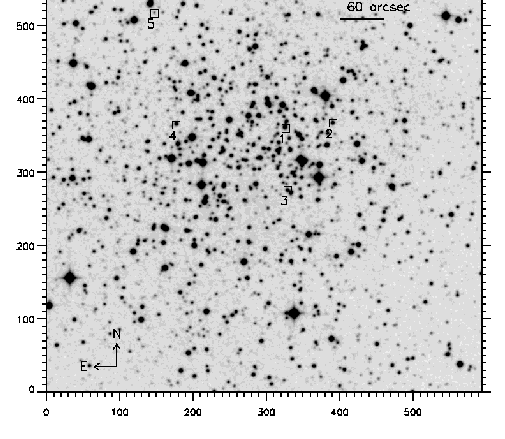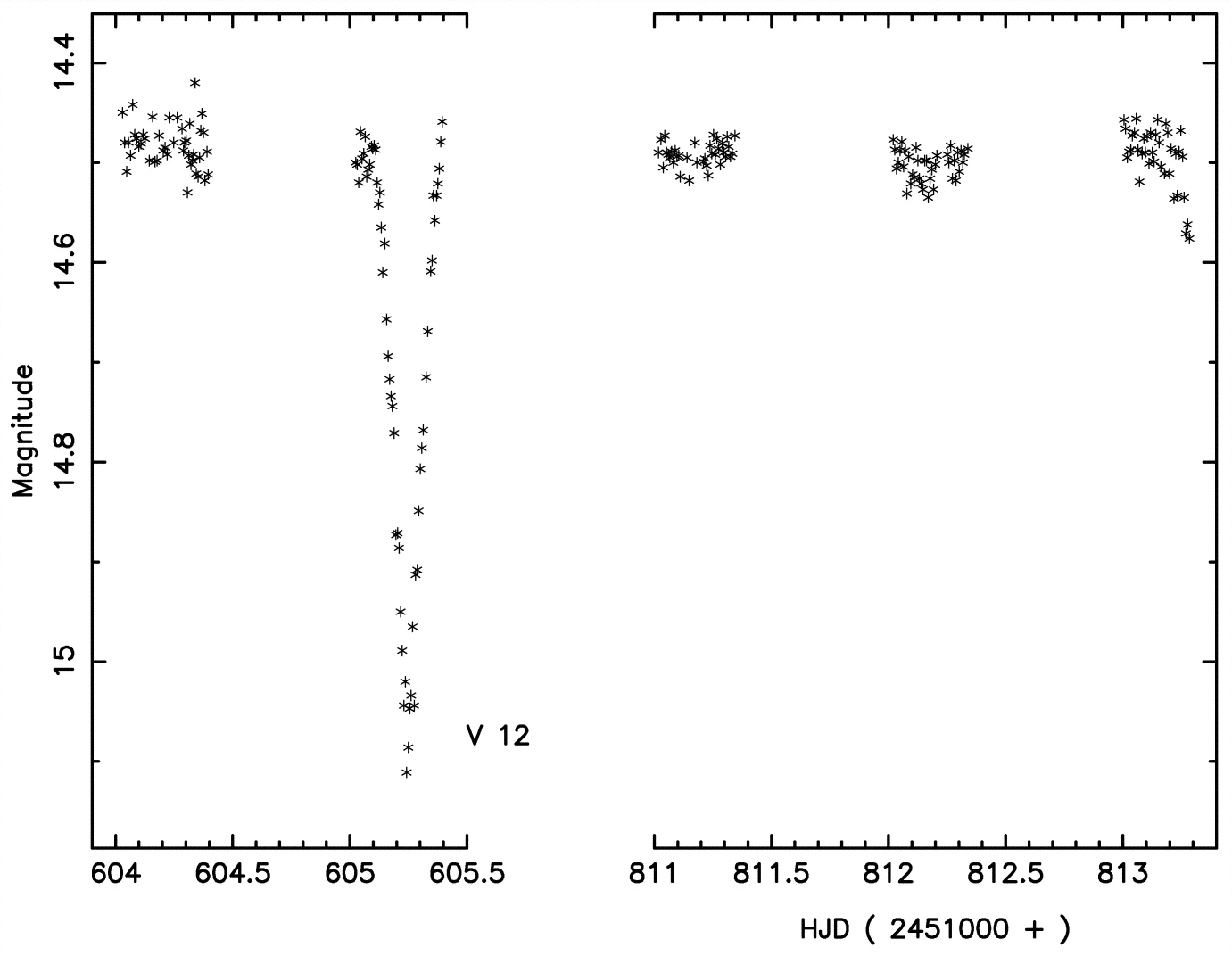
NGC 2506
Cluster CMD
V12 lightcurve
V12 Eclipse
Times
Cluster Photometry (NGC 188)
Cluster Field
Papers
Our project(s), including
obs. time applications.
This cluster is a very interesting target. There are more than one EB system and on top of that, the cluster has a population of blue stragglers, that pulsate (Delta Scuti stars). In addition there are a number of slowly varying stars on the red side of the instability strip. These stars are likely to be of the type called gamma Dor stars. The two EB systems are the stars V4 and V5. The predicted time of the eclipses are given here for each of the systems:
jd0 = 2.65734d + 53375.0d + 2400000.0d ; Time of eclipse for V4 per = 2.8679d
jd0 = 10.6653d + 53375.0d + 2400000.0d ; Time of eclipse for V5 per = 10.078d
The time to observe V4 or V5 is found by adding multiple numbers of the period to the Julian date and convert to date and time and see, if a match with the observing nights is present. The Juliand date given is the Heliocentric Julian Date. A Finding chart follows:

Finding chart. The variable stars V1 to V3 are Delta Scuti stars, V4 and V5 are the eclipsing binary systems.
The same finding chart is also available as a postscript file.
The old open cluster NGC 188 contains one known detached eclipsing binary system, called V12. This system was discovered by Zhang et al. (2002)..
The basic parameters for V12 are:
Ra(J2000) = 00 52 37.74
Dec(J2000) = 85 10 35.2
V = 14.771
B-V = 0.682
Use the paper by Zhang
et al. (2002). to locate the Julian date of
the one known minimum. Then for an assumed period of 6.50356 days,
calculate if there is a possibility of an eclipse during our Teide
observing run and, if so, prepare the observations.
The cluster M67 also contains a detached
eclipsing system with very shallow eclipses (0.08 and 0.004mag for the
primary and secondary eclipse). Check the paper by Sandquist & Shetrone.
(2003). to find the ephemeris of the system
and use it to determine if we are likely to see any primary or
secondary eclipse during our run. If so, prepare the observations.
When planning the exposure times, consider that the depth of eclipses
is only 0.08 and 0.01 mag in I..... so high precision is needed.
The basic parameters for S986 in M67 are:
Ra(J2000) = 08 51 18.0
Dec(J2000) = 11 45 54.1
V = 12.9
V-I = 0.65
Back to TOP of PAGE
A CMD based on a few images from NOT, Aug. 2003 is also available here NGC188.ps.
Since the field of view is only 3x3 arcminutes, there are very few
stars in this CMD, however it is clear, that V12 is located slightly
brighter than the cluster turnoff, but have the same color. NOTE, the
location of V12 in the Zhang et al. CMD is NOT correct.
Back to TOP of PAGE
 Click to enlarge
Click to enlarge
The lightcurve from Zhang et al. (2002).
Back to TOP of PAGE
Photometry file
Readme for photometry file
Simple IDL routine for reading
photometry file
 Click to enlarge
Click to enlarge
Zhang et al. 2002, AJ, 123, 1548 (pdf file
1.5M) Discovery paper for V12
Platais et al. 2003, AJ, 126, 12922 (pdf
file 3.5M) Proper-motion study of the cluster
Back to TOP of PAGE
We are currently undertacking a spectroscopic investigation of V12,
aimed at determining its spectroscopic orbit parameters, such that the
times of eclipse (the period is currently unknown) can be properly
predicted for followup photometry with NOT. Time has been allocated at
NOT, Period 29 for this with SOFIN. The observing time application is
here: NOT-P29-application.ps
Back to TOP of PAGE